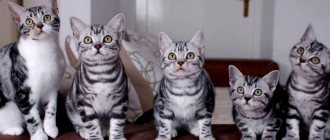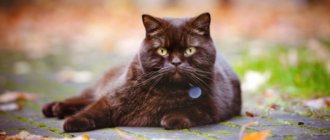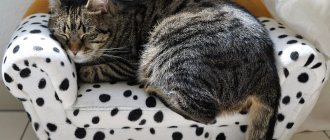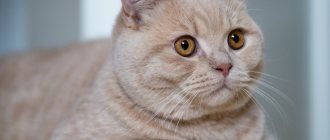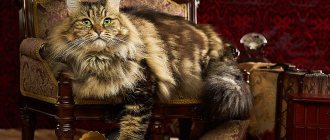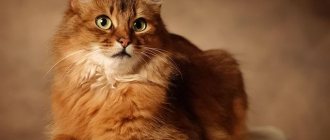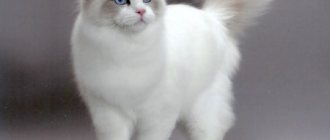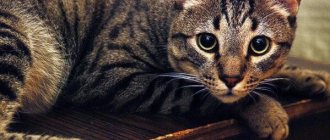History of the breed
Anatoli, or Turkish Shorthaired cat, appeared by the will of nature. The breed formed independently in natural conditions on the Armenian Highlands near Lake Van, currently the territory of Turkey (Eastern Anatolia). These animals are considered to be re-feralized descendants of very ancient domesticated cats. There is a version that the first cats were tamed not in Egypt, but in this region.
Wild representatives of the Anatolian breed live in Iraq, Iran and other countries
It is also rumored that the breed survived another cycle of feralization and domestication during the Second World War. Then the pets were left to their own devices, and then returned to people again.
Wild Anatolian cats live in the wild
This breed is of a certain value in the sense that its genotype is as close as possible to the “wild” type of cultivated and domesticated cats. After all, the longer an animal lives near a person, the more breeders and geneticists take part in its breeding, the higher the likelihood of various genetic abnormalities and hereditary diseases appearing.
For the first time, three white Anatolian cats similar to this one were presented at the exhibition
The Anatolian cat came to Europe quite recently. At the very end of the last century, in 1995, they were first shown at an exhibition in the small German town of Castrop-Rauxel (North Rhine-Westphalia), organized by enthusiasts. The public was presented with three white Anatoli representatives with eyes of different colors. After this, European and American felinologists were engaged in breeding Turkish shorthair cats for several years. In 2000, this breed was officially recognized and its standard was approved by the World Cat Federation (WCF) as a short-haired representative of the Turkish Van.
The Turkish Van has a longer coat
Description of the Anatolian cat breed
To the average person, the Anatolian cat will seem unremarkable. In terms of appearance, it is practically no different from an ordinary outbred domestic dog. These animals are also similar to the Turkish Van, but only have much shorter fur.
External data
According to accepted standards, anatoly has the following characteristics:
- medium or large, massive, tightly built body with a well-developed muscular system, but rather fragile bones (slightly wider in the chest than in the pelvic area);
- weight: females - 3-5 kg, males - 5-7 kg;
- muscular, not very long neck;
- rounded paws of medium length, forelimbs set wide;
- the well-furred, short tail is very mobile along its entire length;
- medium-sized triangular head with high cheekbones and a pronounced strong chin, the profile is almost straight;
- the ears are large, erect, wide at the base, slightly rounded at the tips, set high;
- large oval-shaped eyes, slightly slanted, the color is in harmony with the color of the coat (different eye colors are allowed - heterochromia).
Visually, the Anatolian cat is not much different from an ordinary pet
The coat of Turkish cats is short and thin with sparse undercoat. On the tail, the hair is much longer and is always darker in color than the general tone. It is pleasant and silky to the touch, but a little harsh. When stroking the villi, they crunch very characteristically. The fur of Anatolians is water-repellent and dries quickly.
Anatolian cats are characterized by a vertical white stripe on the forehead between the spots.
The colors of these cats are extremely varied. Most often, the coat has a basic white color, on which there are colored spots. A sign of the Anatoli breed are markings on the top of the head (ears, forehead) and tail. On the face, the spots are divided by a characteristic white stripe - a “mark”. The pattern is also desirable on the tail. The color of the spots varies from cream and red to brown and black. There are individuals with a single color: black, tortoiseshell, blue, red and cream.
The colors of Anatolian cats can be very different.
At one of the cat shows a few years ago we saw an Anatoli cat. She looked like an ordinary mongrel yard animal. But the look of her smart, slightly slanted eyes is simply impossible to convey. They contained universal knowledge about all of us. And this did not at all fit with the simple appearance. It seems to me that all the uniqueness and exclusivity of this representative of the cat world can only be appreciated through close acquaintance.
Character
As true representatives of the native breed, Anatolian Turkish cats are distinguished by their lively temperament and playful disposition. They are active and extremely inquisitive. All events in the house must be under control and occur only with their participation. These animals are highly intelligent, they are well trained and trained. They quickly become attached to people and choose one owner from whom they will not lag behind. A cat quickly remembers its name and is able to associate a combination of words spoken by a person with certain objects or actions. Many owners of Anatolians believe that their pets can communicate quite consciously, making appropriate sounds, and even pointing with their muzzle at the desired object (an empty bowl or a tray that needs cleaning).
The Anatolian cat is distinguished by its jumping ability
Little kittens are very spontaneous, playful and tireless; they can play endlessly and show no signs of fatigue. With age they become a little calmer, but still, on occasion, they will not refuse to have fun and run around the rooms. They easily jump up to 1.5–2 m in height. They can choose any object as a toy, but they especially prefer those that make some sounds. A candy wrapper or piece of paper rolled into a ball can attract their attention for a long time. Cats happily carry a small ball or other small things thrown by their owner in their teeth. With some effort, you can train your pet to fetch slippers like a dog. If the owner is busy or is not at home, then the cat can occupy itself. He doesn't need constant company.
The active and tireless anatoly needs to be provided with a sufficient number of toys. She will appreciate a good multifunctional complex, which will have beds, houses, ladders, scratching posts, tunnels, etc.
Anatoli is musical and can even sing along to the music
A characteristic feature of this Mediterranean breed is musicality, emotionality and talkativeness. Hearing melodic music, cats wag their tails to the beat and sometimes even try to sing along. Strictly speaking, Anatolian cats do not know how to make the usual meow for cats. They show their emotions mostly through quiet vowel sounds, expressed in some form of chirping or chirping.
Anatolian cats are often called chirpers due to the corresponding “speech”, which is similar to the chirping of birds.
Anatolians accompany all their actions with rumbling and snorting. They will describe in vivid colors to the owner who comes home from work everything that happened in his absence. This animal has well-developed facial muscles, thanks to which you can easily read joy, resentment, disappointment and other various emotions on its face. The cat is good at picking up all the differences in voice intonations and knows perfectly well when they are dissatisfied with it. There is no need to punish her. Pets quickly understand what a potty and scratching post are for, and also follow simple commands.
Anatoli loves to swim
Unlike most felines, Turkish cats love water. They swim with pleasure and love to play with the stream running from the tap. They can get along with other animals without difficulty, but small rodents will still be perceived as potential prey. Therefore, you should not have decorative rats, hamsters or guinea pigs at home. Cats love children, play with them enthusiastically, but will not allow themselves to be offended. Pulling such a cat's tail is fraught with unpleasant consequences.
These animals do not show aggression towards strangers; they are friendly and welcoming. But they will not fawn, as they are very devoted to their owners.
External data
Modest at first glance, the appearance of the Anatolian cat, upon closer examination, demonstrates a true cat classic.
The breed standard adopted by the WCF describes the Anatolian cat as a short-haired variety of the Turkish Van cat. Like Van cats, Anatoles (as breeders usually call their animals) are relatively large cats. Adult males weigh 5-7 kg, and females - 4-6 kg.
Over the years, Anatolian cats have retained the appearance of their wild ancestors.
The triangular head with a small nose and a straight, beautiful profile has pronounced cheekbones. These cats have very expressive facial expressions; many people think that they can copy the facial expression of a person. Due to the short hair, the ears visually appear larger than those of Van cats, but smaller than those of Angora cats. The distance between the ears is 4-5 cm. Large expressive eyes of oval or almond shape. Eye color options range from green and light yellow to dark amber. For white cats, different colored eyes are preferred: yellow or greenish and blue.
Anatolian cats have a strong, medium-length build with slender legs and round paws. The hind legs are slightly longer than the front legs. This body structure makes them excellent jumpers; during play, Anatolians can jump up to a height of two meters. The wide chest is well developed. Shoulders the same width or wider than the head. When viewed from above, it is noticeable that the width of the body narrows in the pelvis and hips. The tail is of medium length and thickness, muscular.
The hair of Anatolians is the same as that of Van cats, only shorter. The fur of this cat is unique for its water-repellent properties - almost instantly after getting wet it becomes dry.
Purchasing a kitten
The Anatolian cat is a rare and not very popular breed, so there are no specialized nurseries in our country yet. But purebred kittens can be found from private breeders and in some nurseries that breed other breeds (Turkish Van). They position such animals as exotic.
Buying a purebred kitten is very difficult
Anatolians are bred in Turkey, Greece, Germany, and the Netherlands. There is an anatoly nursery in Armenia.
Criterias of choice
You should only purchase a kitten from a nursery or from a reliable and honest breeder. Visually, it is difficult for a non-specialist to distinguish Turkish cats from ordinary mongrel cats, so you need to carefully study all the reviews and try to contact the owners directly. Otherwise, for decent money, you can get a pet that does not have unique and characteristic characteristics for this breed (a unique voice, intelligence, etc.).
The baby Anatoli will differ from the Turkish Van and Angora in having shorter fur, as well as in the absence of the characteristic fur collar on the neck and “pants” on the hind legs. The fur on the face and entire body of Anatolian kittens is much less fluffy and slightly stiffer than that of other Mediterranean cats. The hairs on the tail are slightly longer than the main coat. In Angora and Van this difference is more significant.
It is imperative to look at the kitten’s parents; they must have all the breed characteristics of an Anatolian cat.
Thoroughbred Anatolians come to our country from Europe and they always have documents confirming their origin.
The baby should look healthy
When choosing a pet, you need to pay attention to the following factors:
- The baby's ears and eyes are clean and do not have any discharge;
- white teeth, light pink palate;
- the tummy is soft, when you touch it the animal does not experience severe discomfort;
- the fur is soft, without sticky or rolled areas;
- the kitten must be active, not cough, sneeze, etc.;
- The baby should not be too afraid, since this breed is not particularly timid.
Kitten age
Experienced breeders donate babies no earlier than eight weeks, when they are already eating like adults. It is better if all the vaccinations required for this age are completed.
WCF standard
Anatolian cat Astghik with kittens
According to the standard adopted by WCF
, this is a short-haired variation of the Turkish Van.
- Body:
The cat is medium to large in size, with significantly developed muscles and a bone structure of medium strength. The neck and chest are massive and strong. The limbs are of medium length, the paws are round. The tail is of medium length, well furred. - Head:
head of medium length in the shape of a truncated triangle. The profile is almost straight. The chin is strong. - Ears:
The ears are large, wide at the base, with slightly rounded tips. Set straight on the head, quite high and vertical. - Eyes:
The eyes are large, oval, set slightly askew. The eye color is uniform and harmonizes with the coat color. - Coat:
short, without noticeable undercoat, fine texture, but “crunchy” to the touch. - Color options:
chocolate, cinnamon and the corresponding lightened (“diluted”) colors (lilac and fawn) are not recognized in any combinations (bicolor, tricolor, tabby). Colorpoint (Siamese) colors due to the presence of the cs gene or “Siamese factor” are also not allowed. Any other colors are recognized and their descriptions are given in the "List of Basic Colors".
Recognized colors
| Color | EMS codes |
| White | ANA w 61/62/63/64 |
| Black/blue/red/cream | ANA n/a/d/e |
| Black/blue tortoiseshell | ANA f/g |
| Black/blue/red/cream/black tortoiseshell/blue tortoiseshell smoky | ANA n/a/d/e/f/gs |
| Black/blue/red/black tortoiseshell/blue tortoiseshell tabby | ANA n/a/d/e/f/g 22/23/24 |
| Black/blue/red/cream/black tortoiseshell/blue tortoiseshell silver tabby | ANA n/a/d/e/f/gs 22/23/24 |
| Van/harlequin/bicolor | ANA n/a/d/e/f/g 01/02 61/62/63/64 |
| ??????? | ANA n/a/d/e/f/g |
Keeping an Anatolian cat
Caring for this breed is not particularly difficult. But you need to take into account some nuances of their content.
Nutrition
Since this breed is native, natural food is preferable for it. Although ready-made dry food and good quality canned cat food from reliable manufacturers are not prohibited.
Quantity and composition of food
Anatoles have an excellent appetite, but they are not at risk of obesity due to their excessive activity and mobility. These cats will never eat more than they need, so there is no need to worry too much about the amount of food they eat. The average amount of feed required for an adult animal is 30 g per 1 kg of live weight.
Natural food is best suited for an Anatolian cat, but you can also feed it with ready-made premium food.
It is better to try to accustom your pet to a certain feeding time. Uneaten leftovers must be removed immediately. This breed is not picky about the composition of feed. We can say that these cats eat everything and will not miss the opportunity to try food from the master's table. But feeding them human food is strictly not recommended, since unnatural food can lead to diseases of the gastrointestinal tract, liver and kidneys.
The diet should consist of the following products:
- meat - turkey, chicken, beef, veal, rabbit (meat is well frozen before feeding, boiling water is poured over it before feeding);
- offal (heart, lungs, etc.);
- fish;
- cereal porridge;
- boiled vegetables;
- dairy products (kefir, sour cream, cottage cheese);
- boiled eggs.
The bowl must contain clean, fresh water, which should be changed daily.
How many times a day should you feed your pet?
Small kittens are fed on a schedule 5-6 times a day; an adult animal needs two meals a day.
The role of a balanced diet in cat health
To maintain the well-being and health of your pet, it is necessary to provide it with proper and balanced nutrition. The protein component should occupy at least 80% of the total diet. After all, these animals are, first of all, predators and in nature feed on live food (rodents, small mammals, etc.). Carbohydrates and fats are also necessary. But there is no need to give cats sweet food (baked goods, candies, chocolate, etc.), salty, peppery, or seasoned with spices. In addition, the menu includes vitamin and mineral supplements.
Meat should make up the majority of the diet
The diet is especially important for young, rapidly growing pets.
By and large, you should try to feed all cats with food that is natural and familiar to them, even the most exclusive and purebred ones. Another thing is that it is much easier to open a plastic bag with a slight movement of your hand and pour the prepared food into a bowl. sexpromo Not all of us can afford to tinker with our cat’s diet on purpose.
Appearance care
Turkish Shorthair cats are excellent at grooming themselves . They are particularly neat and never look sloppy or untidy. But sometimes they need a little help.
Combing
The Anatolian's short coat is brushed once a week to remove dead hairs. To do this, use a special soft brush. This procedure is especially relevant during the molting period.
It is best to remove dead hair with a soft brush.
We brush our shorthaired Siamese cat about once every two weeks. But during the molting period, especially in the spring, you have to do this more often. What I like best is a fine-tooth comb.
Bathing
Water procedures are carried out as needed. It is usually recommended to bathe cats no more than once a month. But because of their love for water, Turkish cats constantly climb into it and ask to wash them. Therefore, if the owners have free time, then it is not forbidden to wash their pets more often.
Anatolian cats love to swim
I met a cat who loved to swim. He sat in the bathroom for hours and waited for water to be poured into it. If only one of the family members intended to take a bath, he was always ready to join the company.
Ear care
The ears should be periodically (2-3 times a month) wiped with chlorohexidine or a special ear care solution for animals. Use cotton pads and swabs to carefully remove accumulated wax.
Several times a month you need to inspect your ears and wipe them with a cotton swab moistened with warm boiled water or a special ear care solution.
Eye care
Every morning, use a cotton swab dipped in warm water, a decoction of herbs (calendula, chamomile, etc.), tea leaves or a special liquid to wipe the cat’s eyes.
Every morning you need to wipe your cat's eyes with a damp cotton pad.
Nail care
At least once every 2-3 weeks, the pet’s claws are shortened, as they are hard, strong and grow quickly in this breed. Use special scissors (claw clippers). It is necessary to provide the animal with a scratching post, or preferably several. If you do not monitor the length of the claws, the cat will use interior items (sofa, chair, table legs, etc.) to independently remove dead keratinized layers.
Nails should be trimmed at least once every 2-3 weeks using a nail clipper.
Dental care
Use a special paste that does not require rinsing (sold in veterinary stores and pharmacies) and a soft brush to brush the cat’s teeth 2-3 times a week.
It is necessary to brush your cat’s teeth with a special toothpaste 2-3 times a week.
Toilet
Turkish cats get used to the litter box quickly. They usually have no special complaints about the design of this hygiene item; any sufficiently large cat potty will suit them. You can use a variety of fillers. For small kittens, it is recommended to use wood and paper pellets. If the baby accidentally swallows them, it will not harm him.
You need to keep an eye on the cleanliness of the toilet, otherwise the pet may choose another, completely unintended place.
Walks
Anatolian cats are free-spirited and love to walk in nature. Living in a private or country house is suitable for them. But even in the city, they also happily walk down the street on a leash, which they quickly get used to.
It’s better to walk with Anatoly on a leash
Nutrition
They have an excellent appetite. The animal does not suffer from obesity. If you feed your pet industrial products, you should give preference to high-quality products. At the genetic level, it is adapted to natural nutrition and has all the necessary microelements and vitamins.
Dry food helps avoid dental problems.
Despite the fact that these “animals” love meat raw, it must be fed cooked. The diet should contain the following ingredients:
- Fish, preferably sea fish;
- Chicken eggs;
- Chicken;
- Cereals;
- Vegetables;
- Veal;
- Sour cream;
- Greenery;
- Fruits.
- Offal.
It is strictly forbidden to give smoked and fried food to your pets. You should not give sweet and starchy foods.
Defects of the Anatolian breed
This native breed is naturally healthy and has a strong immune system. She does not have any genetic defects. But there are several color restrictions.
Tendency to diseases
Due to good heredity, Anatolian cats are not prone to any genetic diseases.
Anatolis are distinguished by excellent health and have no tendency to disease
It is necessary to vaccinate pets in a timely manner and give them anthelmintic drugs. Deworming is carried out at least once a quarter if the cat is often outside.
Invalid colors
The following colors of Anatolians are prohibited by the WCF standard:
- colorpoint (Siamese);
- faun (light beige - the color of a fawn);
- chocolate;
- cinnamon (warm light chocolate);
- lilac.
Fawn and cinnamon colors are not allowed in Anatolian cats
Diluted light chocolate colors are not recognized in any combination (bicolor, tricolor, etc.) and are not allowed for exhibitions.
Character
There is never a dull moment with Anatolian cats. They love outdoor games and will happily chase a bow on a string until they are old. During play, Anatoles are not prone to aggression, and if they are scratched, it will be an accident.
The level of intellectual abilities of Anatolian cats is simply amazing. Quick litter training, mastering simple tricks and commands - this is just a small list of what these cats are capable of. Thanks to their intelligence, Anatolians are able to give a sign to the owner that something is bothering him or about any disturbances in the house, for example, that a faucet is leaking or milk has run out.
Anatolian cats are kind and sociable
The sounds that Anatolian cats make deserve a separate description. This is not just the usual meow, but rather a chirp. These cats can also produce similar vowel sounds. At the same time, their voice is quiet and melodic.
Many owners claim that their Anatolian cats sing along to the music that is turned on, and while listening to it, they also “conduct” their tail.
Anatolians treat guests and other people who come to the house kindly and tolerantly, but they do not allow unnecessary liberties towards themselves. Since the Anatolian cat's ancestors were wild animals, it is impossible to predict its relationship with other domestic animals. Everything will depend on their friendliness and meekness. But cats are unlikely to survive proximity to small birds or rodents - their hunting instinct is too strong.
Breeding the Anatolian cat breed
Breeding Anatolian cats is very difficult due to their extreme rarity. Breeding with other breeds is not allowed. Kittens born as part of forced experimental breeding (crossing with Vans and Turkish Angoras) are not registered as full-fledged representatives of the breed.
A partner for anatoly must be selected in advance
Quite a long time ago, when the Siamese cat breed was rare, it was difficult for us to find a mate for our cat. In addition, our beauty did not welcome everyone; sometimes we had to take her straight home. But with one cat she had almost human love. It was very touching to see two sleeping cat bodies curled up into one ball.
Partner selection criterion
You should choose a pair for your pet based on the following rules:
- a pedigree is required;
- healthy appearance and good activity;
- there should be no exterior defects (wrong color, bite, etc.);
- there should be no diseases or defects that are inherited (kinked tail, cryptorchidism, etc.);
- all vaccinations (rabies, complex vaccine, etc.) must be completed in advance (2-3 months in advance);
- favorable living conditions for the partner;
- breeding clearance.
A purebred cat must have a pedigree
It is advisable to familiarize yourself with the existing offspring.
At what age should you give your pet for the first mating?
Anatolian cats reach sexual maturity quite early. Females have their first estrus already at 7–8 months, while males are ready for mating closer to a year. Veterinarians strongly advise not to breed cats before two years of age, and preferably after three. It is believed that during early pregnancy, the cat’s body is not yet ready to fully bear cubs. For cats, the optimal age is 1.5–2 years.
If pregnancy is too early, the likelihood of weak and sick offspring is high.
How often can a cat give birth?
There is a lot of controversy surrounding the question of how often a cat can give birth. There are radically opposing opinions on this matter. Some believe that a female should kitt after every heat (3-5 times a year). Others firmly believe that it would be harmful for the animal to produce offspring more than once every 12–18 months. However, most breeders and veterinarians believe that a cat can give birth 1-2 times a year without any damage to its health.
Veterinarians believe that a cat needs to give birth 1-2 times a year.
From my own experience, I will say that a lot depends on the cat itself. Some individuals tolerate four pregnancies a year well, and for some, even one pregnancy will be too much. Often nature itself regulates this process and not every mating ends in the appearance of offspring.
Feeding
Anatolian cats are not picky about food. Over a long period of time, the digestive system of pets has adapted to a varied diet. But Anatolians still digest natural food better than ready-made food, even the highest quality.
The diet should be dominated by protein foods, supplemented with fiber and healthy fats, vitamins and minerals. Below is a list of suitable and prohibited foods for Anatolian cats.
| Can | It is forbidden |
| Raw lean meats | Everything salted, smoked, fried, fatty and spicy |
| Bird, rabbit, nutria | Any baked goods |
| Sea fish | Confectionery |
| Dairy products | Legumes |
| Fresh and boiled vegetables | Citrus |
| Porridge - no more than twice a week | Unknown herbs |
Any treats from the host's table are strictly prohibited.
With a natural menu, be sure to include vitamin supplements in the diet, which the veterinarian will recommend. If the owner still prefers to feed the animal with ready-made food, then it is better to buy industrial diets labeled “super-premium” and “holistic”.
An Anatolian cat will never eat more than it needs. And if she shows interest in the owner’s food, then this product contains what she lacks in her diet. Thanks to their excellent metabolism and activity, Anatolians are not prone to gaining excess weight.
Castration and sterilization
If you do not plan to carry out breeding work with the animal, then it is better to castrate or sterilize it.
At what age should surgery be performed?
The optimal age for surgery for a cat is considered to be from 8 to 12 months. It is advisable to do this before the first heat. It is also possible later, but it is better not to delay and do it before two years.
The procedure is performed on cats from 10 months to 1.5–2 years. Surgical intervention should be carried out in a timely manner, while the animal’s behavioral habits have not yet fully formed. The younger the operation is performed, the easier the animal will tolerate it.
Spaying and neutering too early can lead to slow development of the pet. The animal grows miniature.
Caring for your pet after surgery
After surgery, the pet’s condition must be carefully monitored to avoid complications and negative consequences. Proper postoperative care is as follows:
- the pet must be provided with peace and quiet;
- To prevent the animal from licking the stitches, it is necessary to put on a special post-operative blanket and an “Elizabethan” collar;
- after surgery, do not give food for 10–12 hours;
- Once a day, carefully inspect and treat the seams with hydrogen peroxide, chlorhexidine, etc.;
- do not allow the cat to remove disturbing objects and do not allow him to move too actively;
- It is allowed to give your pet painkillers (Pervicox, Ketofen, etc.), but you must first contact your veterinarian for advice and dosage recommendations.
To prevent licking, you need to put a special post-operative blanket on your cat.
If your pet takes a long time to come to his senses, does not eat anything for more than three days, and also if his stitches look bad (wet or fester), then you should definitely contact a veterinary clinic.
Diseases
The breed was bred naturally and therefore does not have any genetic diseases. The Anatolian cat is characterized by all those diseases that any cat can pick up:
- Worms.
- Fleas.
- Ticks.
- Toxoplasmosis.
- Eczema.
- Rabies.
Therefore, it is important to check your cat in time for the presence of parasites and treat it with special preventive agents before walking outside. The animal is dewormed at least once every few months.
Bathe your pet using flea shampoo.
It is important that the animal does not come into contact with yard cats. And after walks he should wash his paws with soap
At least once every six months, an Anatolian cat can be shown to a veterinarian. It is necessary to vaccinate on time. If a cat is injured, the wound is carefully treated and for some time until it heals, the cat is not allowed to go for walks.
With proper care, this old-timer can last 20 years.
Characteristics of the Anatolian cat in the table
| Breed name | Anatolian cat |
| Country of origin | Türkiye |
| Time of birth of the breed | officially recognized in 2002 |
| Character traits | curious, playful, kind |
| Weight | 4-7 kg |
| Height (height at withers) | up to 30 cm |
| Lifespan | 13-16 years old |
Anatolian cat video
The Anatolian cat is a true and loyal friend. She is lively, smart and talkative. Ideal for both singles and large families. True, those who like silence in the house will not like the pet.
Table: pros and cons of the Anatolian cat breed
| Advantages | Flaws |
|
|
Who is it suitable for?
The exotic Turkish breed is suitable for anyone who does not have time to carefully care for their pets. The Anatolian cat is able to take care of itself. She does not suffer much from loneliness and will always find something to do. In the warm season, she practically rarely appears at home if her owners allow her to walk on her own. We must remember to give the Anatolian cat Van anthelmintic drugs for prevention and everything will be fine with her health.
A smart animal to talk to. She practically never shuts up. For lonely people he will become a true friend and interlocutor. In addition, the hostess will affectionately call her mother. The Anatolian cat also gets along with children and other animals. The breed is non-aggressive, friendly, kind, intelligent. Short hair does not fall into clumps, and a small child will not end up with it in his mouth, which is also important. The Anatolian cat eats twice a day in impressive portions. Small kittens should be fed up to 5 times a day. In general, the Anatolian cat has a wayward character, but you can put up with it. She listens when she is scolded, corrects her mistakes, and is absolutely not vindictive.
Reviews from Anatoli owners
I don’t know how to describe the admiration that knows no bounds for this cat. He is like a member of our family; if something suits him, he purrs and calls for him, indicating what is needed. On our farm, we have nutria, quail, and chickens who were worried that he wouldn’t touch them, but he pays zero attention to them, he will carefully climb out onto the box and lie down over them. But it can sit in ambush for a day on a mouse or sparrow, and still chirp, distracting the bird’s attention. It happens that I turn on the microwave and go to the computer, the microwave starts beeping when it’s finished, so the cat, sitting across the room, comes up and calls, touching his shin with his paw, calling me to the kitchen. He specially left sausage on the table, the fish was already dry until the morning, and in the morning he comes to the bed, checks that his wife is breathing, I am breathing, comes up to my feet and starts rubbing his heels with his mustache. What do you think? You need to get up and go to the feeder and show him where and what to eat. Sometimes at night he gets bored and comes up to him, wakes him up and calls him to the computer.
ria
https://xn--e1afgbgom0e.xn--p1ai/forum/forum2/topic213/
I have Anatolian. Very angry. He only loves me, he can’t stand strangers. He doesn’t like my parents, especially my dad. Very clever. I don’t know about everyone else, but mine doesn’t steal from the table. Very faithful. With a cat like this, you don’t need a dog
Kareli908
https://www.zooclub.com.ua/2668?t:354
For a non-specialist, EKSH is no different from domestic cats. Anatoli cats are intelligent, with a gentle melodious voice. Not only do they love to swim, but they have water-repellent outer hair, so they dry quickly. Each breed has its own characteristics.
Soul
https://eursh.ru/forum/viewtopic.php?f=27&t=179&sid=f8f5ae0ef612a687afe1872f09c3a962
A unique breed: at first we thought the kitten was strange - it doesn’t meow, but chirps quietly. It turned out to be a peculiarity of Anatolian. A very intelligent animal! The coat is without undercoat, very silky to the touch - you want to press it to your cheek... A very sociable animal, it doesn’t stay alone in the room if someone at home is sure to run after us. My child chuckled sarcastically about the “intelligent animal.” What a very curious girl! He wants to stick his nose into all your affairs - from the computer to the broom! And if he sees a small ball or a laser in his hands, he prepares a show for the whole family. Jumping after a target to the ceiling with a flip in the air is a very impressive sight!
Anatolievna
https://mauforum.ru/viewtopic.php?f=108&t=19001&sid=df00d2747f5917e39d9126109bc3d662
When the summer season began, high hopes were placed on my home hunter: we believed that she would catch all the rodents. But it was not there! The cat ran around the house and stomped like a hippopotamus - what a hunt there is! We decided that she didn’t know what a mouse was, and we needed to “introduce” them. They caught the rodent in a box and brought it to Krita - study it, they say. The mouse froze and did not breathe. The cat extends its paw and, touching it lightly, immediately pulls it away with disgust and shakes it, as if it had gotten dirty! She turned away and walked away!
Tatiana Stepanova
https://zcats.ru/porody_koshek/stati_o_porode/98-anatoliyskaya-koshka.html
Photo gallery: Anatolian cats
Anatolian cats are very difficult to find in catteries
Anatolian cats come in a variety of colors
Anatoles differ from Turkish Vans in having shorter hair.
White Anatoles often have different colored eyes
The Anatolian cat's tail is always darker than the rest of the coat.
White Anatolians do not always have different colored eyes
Anatolian cats come in a variety of colors
Sometimes it is difficult to distinguish anatole from an ordinary yard cat
The Anatolian breed is beautiful for its exclusivity. It is unlikely to suit those people who love a quiet and calm life. A talkative and sociable pet will require a lot of attention. But this cat can become an excellent companion and friend to a lonely person.
Colors
The Anatolian cat can be any color, from pure white to jet black. The breed standard allows for a large number of colors. But there should be one general pattern: the shade of the tail should be darker than the color of the body.
Of the frequently occurring colors in Anatoli, the following are noted:
- white;
- black;
- blue;
- gray;
- redhead;
- tortoiseshell.
Anatolians attract breeders with their variety of colors
Although the color range is quite wide, the standard does not recognize kittens as purebred if they are born with chocolate and cinnamon (cinnamon) colors. A purebred Anatolian cat cannot have the same colors as Siamese or Burmese cats.
